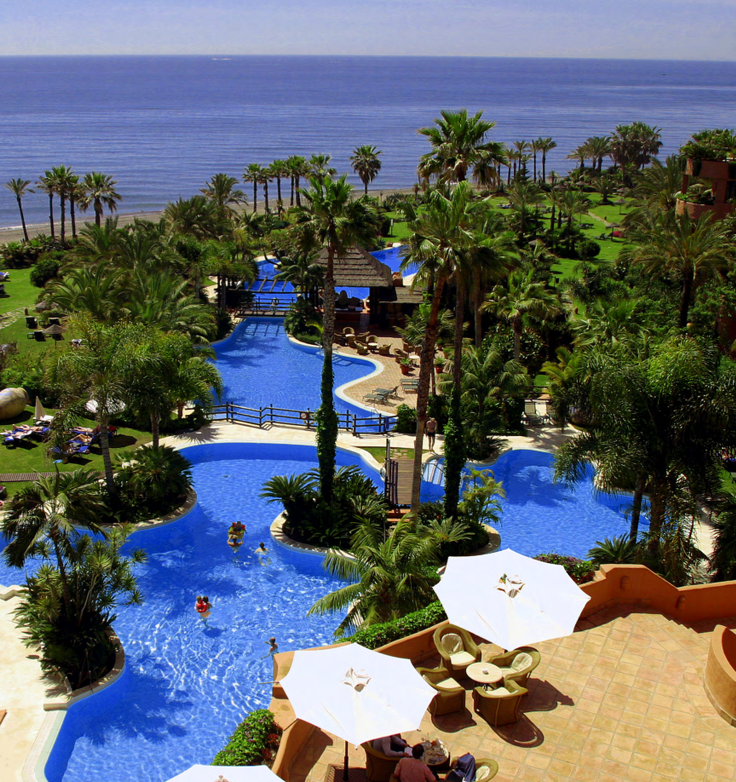Autumn’s the time to see the Costa del Sol’s classier side

Kempinsky Hotel, Estapona
IN THE 1960s, when the package holiday boom took off, the Costa del Sol’s image was forever tarnished. You think of it now as a land of fish and chips and lager, where bull-fighting has given way to the more consensual, but no less cruel, British sport of Holiday Endurance. Men test out how red they can burn their beer bellies without the paramedics being called. Women compete to see how many waiters they can get to dance the horizontal bolero. Both sexes investigate just how many jugs of sangria a person can drink while hovering this side of coma.
And yet this beautiful stretch of sandy coast, with its 320 days of sunshine and a rich history that includes Moorish architecture dating back to the 15th century, has so much more to offer. Especially in autumn, when the furnace of summer gives way to a pleasant, short-sleeved 23 to 28 degrees.
Take Malaga. For many, this is just the gateway to the beach, the place where their plane connects with their coach. But it’s also a historic town well worth a day’s exploration.
In the centre stands a peculiar cathedral. Its official name is the Incarnation, but locals all call it “Manquita”, or “one-armed cripple”. Symbolically, it’s less a testament to the glories of God than a giant monument to mañana: it took three centuries to build, from 1528 to the end of the 18th century, but they ran out of money and the right-hand tower is still missing.
GREAT PAINTER
More edifying is the Picasso Museum, which opened in 2003. The great painter never returned to the city of his birth, yet still it holds an impressive collection of 233 works, somewhat confusingly arranged by subject rather than chronology. It may lack the world-class works of the Picasso Museum in Barcelona, or the heart-stopping Guernica housed in Madrid, but it provides a fascinating glimpse into his working methods. And, for those not quite so high-minded, an opportunity to snigger at pictures of Picasso’s first wife who, like some Bond girl from the Roger Moore era, was called Olga Kokhlova.
The city is full of charming little restaurants and bodegas, like the equally unfortunately named El Pimpi, with its blue flower pots climbing the walls and sprigs of rosemary strewn underfoot. In fact, Malaga’s said to have more bars per square metre than anywhere in Europe. And, once fortified with tapas and a good local wine, you can climb the splendid Muslim fortress atop the hill: the magical-sounding Alcazaba, or “Protected Palace”.
All this, straight off the plane. There are plenty of places to stay in Malaga, but you’ll want to venture onwards. Speed past the billboards advertising breast enlargement on the cheap, and the lobster-bellied package-holiday enclaves such as Torremolinos, and make for one of the more elegant hotels further along the coast.
We stayed in the five-star Hotel Kempinski Bahia Estepona, recently refurbished throughout. Brilliantly, it is designed so that each of 132 rooms and 15 suites face on to the sea and the hotel’s own beach. For those who prefer their water waveless, it offers three swimming pools fringed by palm trees. Murals and giant terracotta pots throughout the hotel are hand-painted in a very Picasso/Matisse style by the artist Stefan Szczesny. And the food is phenomenal, thanks in part to the organic vegetable garden and orchard that form part of the extensive grounds.
CELEBRITY GUESTS
The hotel has its own 16-century tower – one of 20 fringing the coastline to warn against Moorish attack – which is a popular venue for wedding parties. And it has a more modern tower, too: the recently added two-storey Royal Suite, whose many celebrity guests must remain confidential (oh go on then, Hugh Grant was one). It affords a wonderful view from its Sky Lounge right out to the Rock of Gibraltar, and its terrace has a powerful telescope “for looking at the stars”. When I peered through the lens, it became apparent what kind of stars the previous guest had been scrutinising: it was trained on the sunloungers by the pool.
The nearby town, Estepona, is a pretty fishing village with blue and white buildings, and a simply phenomenal market on the Marina. Among the local trinkets are several stalls selling designer sunglasses and bags at ridiculously low prices, indistinguishable from the real thing. It may or may not be ethical, but as gifts they’ll be more popular back home than a bullfighter on a painted plate.
And so to the more modern attractions of the region. The Costa del Sol is also informally known as the Costa del Golf: there are more than 50 courses between Malaga and Gibraltar. The Hotel Kempinski offers discounted packages, as well as activities ranging from horse-riding to Harley-Davidson hire. And the Casino de Estoril, on which Ian Fleming based the Casino Royale, is only a short cab ride away. And a very long walk back if you lose it all on number 32.
CHI-CHI NIGHTLIFE
But it’s the nightlife for which the area has become justly famed. Even a small resort like Estepona has a huge club and several music bars. We headed to Puerto Banus of a Saturday night, a chi-chi waterside enclave whose prices are not quite as eye-watering as ritzy Marbella.
We kicked off with Zombie cocktails on a full-size pirate galleon, kitted out with sail, plank and all. You could tell it was a pirate galleon, because, yes, a pirate suddenly appeared, with a dusky maiden protesting feebly over one shoulder. He proceeded to lash her to the mast before fighting a duel to the death with a dashing hero. Expecting none of this, we peered at our Zombies, wondering blearily just how strong they were.
We finished off in a cavernous club where we laid bets on which of the glamorous podium dancers were actually transsexuals (about 50-50, I’d say). But that’s just normal nightlife here: the club’s chief gimmick was a resident sax-player in designer shades, who wandered through the crowd blowing cool licks when the dance music got instrumental.
One well-refreshed British clubber took a particular shine to the saxophonist: a long-haired lovely with Bambi legs and a miniskirt the size, though perhaps not the adhesiveness, of a postage stamp. Every time the saxophonist came out, she would grind her hips suggestively into his, um, horn, as he, erm, blew.
London’s West End was never this fun. We eventually fell into a taxi about 4am, having realized one thing. If the Costa del Sol has a reputation now for hedonism rather than history, that’s not always a bad thing.
Rooms start at about €180, with suites from €400. Ryan Air, EasyJet and Aer Lingus all offer cheap flights to Malaga.






